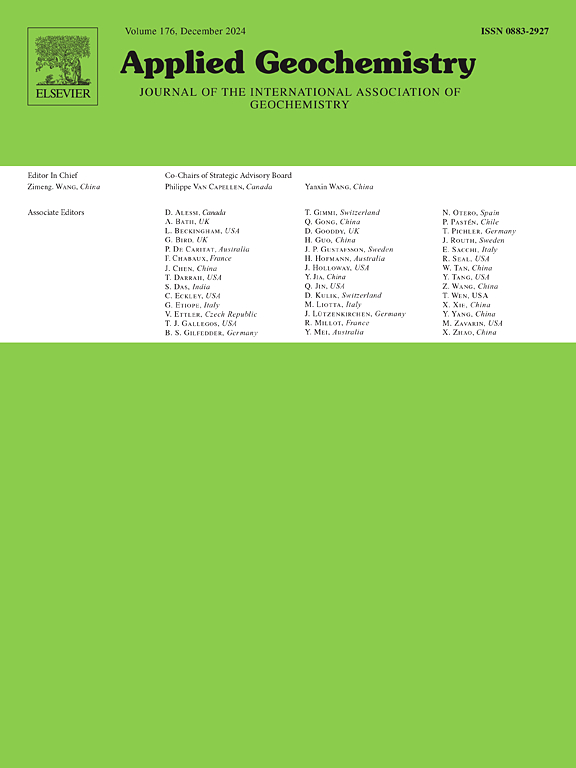Identification of molybdenum immobilization mechanisms in naturally contaminated excavated rocks and soils stabilized with zero-valent iron
IF 3.4
3区 地球科学
Q1 GEOCHEMISTRY & GEOPHYSICS
引用次数: 0
Abstract
Chemical stabilization of naturally contaminated excavated materials could be used to limit environmental risks. Nevertheless, due to the low levels of contamination in such materials a more precise characterization of immobilization mechanisms is required. To overcome this lack of data, zero valent iron (Fe0) was used as a stabilizing agent at rates of 1 or 3 wt% in four different sets of excavated rock and soil from the Paris basin that were contaminated with low levels of molybdenum (with a total content of from 2 to 11 mg Mo kg−1) but that involved leachability issues. Molybdenum (Mo) release was reduced by at least one order of magnitude after adding Fe0 over a wide pH range (i.e. 2 < pH < 12). Geochemical modeling of pH-dependent leaching tests was done to identify potential immobilizing mechanisms. For Mo, experimental results were well represented at pH close to and below the natural pH of the samples by considering surface adsorption with iron (hydr-)oxides involving non-, mono- and bi-protonated Mo surface species. Zero valent iron stabilization remained relatively significant under alkaline conditions where complexation of anionic species was not favored. These results suggested that stronger binding mechanisms are likely to occur concomitantly with surface adsorption. Finally, thanks to their high sensitivity, μ-particle-induced X-ray emission (μ-PIXE) and μ-Rutherford backscattering spectroscopy (μ-RBS) were successfully used to directly observe Mo presence in iron (hydr-)oxides formed after addition of Fe0.

零价铁稳定自然污染开挖岩石和土壤中钼的固定机制鉴定
对自然污染的挖掘材料进行化学稳定可以降低环境风险。然而,由于这种材料的污染水平较低,需要对固定机制进行更精确的表征。为了克服这一缺乏数据的问题,研究人员将零价铁(Fe0)作为稳定剂,在四组不同的巴黎盆地出土的岩石和土壤中以1或3 wt%的速率使用,这些岩石和土壤被低水平的钼污染(总含量为2至11 mg Mo kg - 1),但涉及可浸出性问题。在较宽的pH范围内(即2 <)加入Fe0后,钼(Mo)的释放量至少降低了一个数量级;pH值& lt;12)。对ph依赖性浸出试验进行了地球化学模拟,以确定潜在的固定化机制。对于Mo,考虑到铁(氢)氧化物的表面吸附,包括非质子化、单质子化和双质子化的Mo表面物质,实验结果很好地代表了pH接近或低于样品的自然pH。零价铁的稳定在碱性条件下仍然相对显著,阴离子络合不受欢迎。这些结果表明,更强的结合机制可能伴随着表面吸附而发生。最后,利用μ粒子诱导x射线发射光谱(μ-PIXE)和μ-卢瑟福后向散射光谱(μ-RBS)的高灵敏度,成功地直接观察了添加Fe0后形成的铁(氢)氧化物中Mo的存在。
本文章由计算机程序翻译,如有差异,请以英文原文为准。
求助全文
约1分钟内获得全文
求助全文
来源期刊

Applied Geochemistry
地学-地球化学与地球物理
CiteScore
6.10
自引率
8.80%
发文量
272
审稿时长
65 days
期刊介绍:
Applied Geochemistry is an international journal devoted to publication of original research papers, rapid research communications and selected review papers in geochemistry and urban geochemistry which have some practical application to an aspect of human endeavour, such as the preservation of the environment, health, waste disposal and the search for resources. Papers on applications of inorganic, organic and isotope geochemistry and geochemical processes are therefore welcome provided they meet the main criterion. Spatial and temporal monitoring case studies are only of interest to our international readership if they present new ideas of broad application.
Topics covered include: (1) Environmental geochemistry (including natural and anthropogenic aspects, and protection and remediation strategies); (2) Hydrogeochemistry (surface and groundwater); (3) Medical (urban) geochemistry; (4) The search for energy resources (in particular unconventional oil and gas or emerging metal resources); (5) Energy exploitation (in particular geothermal energy and CCS); (6) Upgrading of energy and mineral resources where there is a direct geochemical application; and (7) Waste disposal, including nuclear waste disposal.
 求助内容:
求助内容: 应助结果提醒方式:
应助结果提醒方式:


